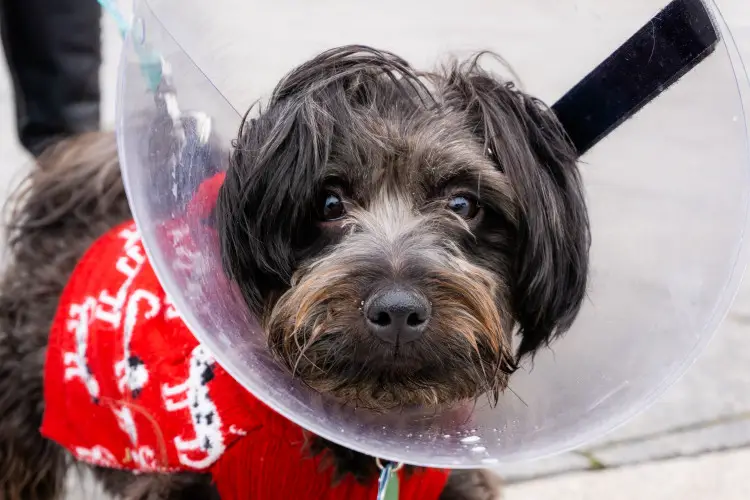How Long Will A Dog Be In Pain For After Spaying?
Your pet’s surgery will be done under general anesthetic, which means she’ll sleep through the procedure. Just like humans who undergo surgeries, she’ll probably be groggy as the general anesthesia wears off, and she will feel some pain after leaving the veterinary clinic.
The veterinarian will provide your pet with an injection of pain medication and send you home with a prescription that you can add to her food.
Every dog is different, but it is typical for the procedure to cause discomfort for two to three days as the incision heals. This may cause the dog to become agitated, whine or whimper, or resist being handled. She will probably look as if she is down in the dumps. I know my dog did for a few days afterward.
Your pet may advise that your dog may not want to eat for a while.
These behaviors are normal, and as a pet owner, you should not be overly concerned.
Is Spaying a Dog the Same as Neutering? What Does this Term Mean?
Dog owners who wish to eliminate their male or female dog’s ability to reproduce will often say they plan to have their dog fixed or sterilized by a vet.
Spaying and neutering are simply the gender-specific terms for the procedure. Neutering is when the testicles and associated structures are removed, including the testicular blood vessels and spermatic ducts in a male dog. Spaying is when a female dog’s ovaries and uterus are removed.
When Should I Have My Dog Spayed?
The American Animal Hospital Association (AAHA) recommends that small breeds under 45 pounds be spayed before they have their first heat cycle at around 5 or 6 months of age. The AAHA recommends waiting a bit longer to spay, 5 to 15 months of age, for larger breeds.
If you spay her as a puppy and before a first heat can help reduce her risk of developing dog mammary cancer. Your veterinarian can advise you on the best approach for your female dog.
How Can I Help With Her Recovery?
Your veterinarian will likely send your dog home from the clinic with an Elizabethan collar so that she cannot lick or bite at her incision. The incision will be held tight by surgical glue, but you’ll still need to take care that she does not have access to it for a while.
As uncomfortable as she may be wearing it, you must make sure it stays on. This will help prevent the dog’s wound from opening up or becoming infected.
Limit her activity to not exert herself unnecessarily, including taking her for short walks on a leash rather than letting her run free.
Be sure to check her spay incision at least twice daily to ensure it is not oozing blood or pus. Keep the dog’s incision site clean and follow all post-op instructions your veterinarian has provided.
Your vet will have set up a follow-up appointment to see how her recovery is going, but don’t hesitate to call the clinic if she continues to show signs of distress or you don’t feel she is mending as quickly as she should.
The vet will recommend pain relief in the form of pain meds to be taken over a specified schedule.

Why Should I Have My Dog Spayed?
You’ll Help Curb the Overpopulation Problem
According to the American Society for the Prevention of Cruelty to Animals (ASPCA), about 3.3 million unwanted puppies find themselves in animal shelters or rescues each year. About 670,000 of them end up being euthanized.
Unless you plan to breed your dog, you should have your female dogs spayed as a responsible dog owner. It’s the best way to curb the overpopulation problem. Related thought: do you know how many puppies a chihuahua normally has?
Your Dog Will Behave Better
An unaltered female allowed to go into heat can be a handful. Spaying her before her first heat lets you avoid cleaning up after bleeding and spotting. You also won’t have to worry about her trying to maneuver past you every chance she gets to try to get out the door.
Your Dog Will be Healthier After Spay Surgery
A spayed dog is less likely to develop several cancers and diseases like pyometra, a severe uterine infection that can be fatal. On average, a spayed female will live 23 percent longer than an unspayed female.
You’ll Save Money
Spaying your dog comes with a price tag, but the costs of having to care for an “accident” litter are significantly higher. Also, many fees for dogs and cats alike, such as boarding and licensing, are lower if your pet has been sterilized.
Final Thoughts On Spaying
While spaying is a routine veterinary procedure, it still involves surgery, which means there is always a chance for complications.
If your pet exhibits breathing problems, vomiting, loose stools, or excessive panting post-surgery, bring her in to see your veterinarian right away.
